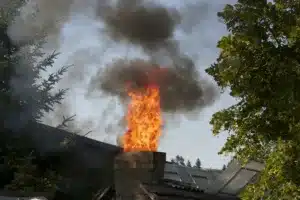Creosote is a dangerous, carbon-based chemical that is formed when wood or fossil fuels are burned. If you have a wood-burning stove or fireplace in your home, chances are there is buildup of this chemical in your chimney. Let’s take a more in-depth look at creosote and how to handle it!
What are the causes and dangers of creosote?
Burning wood with inadequate airflow presence leads to the incomplete combustion of oils in the wood. The smoke is carried up through the chimney and the oils with it, which condense on the inner surface of the chimney. The black residue that builds up is called creosote. It is tar-like and sooty in appearance. It can produce an unpleasant odor that is worse in summertime when the overall humidity is higher. The more creosote builds up (sometimes inches thick), the more airflow is restricted in your chimney when burning wood fires.
The dangerous side effects caused by coming into contact with creosote itself, or touching/consuming anything in your home contaminated by creosote include:
- Skin irritation
- Rashes
- Mental confusion
- Stomach pain
- Burning of the throat and mouth
- Kidney or liver damage
- Skin cancers
- Unconsciousness and death (when exposed to large quantities)
How do I prevent creosote?
When dealing with creosote, the most successful method of approach is reduction, rather than prevention. Although creosote is never 100% preventable while burning wood fires, there are plenty of ways to minimize the presence and build-up of it in your chimney:
- Do not burn freshly cut, unseasoned firewood.
- Opt for natural, seasoned wood over artificial packaged logs.
- Burn hot fires that consume combustion by-products.
- Avoid slow, smoldering fires.
- Minimize the use of fireplace inserts and glass doors, as these restrict airflow.
- Schedule regular chimney cleanings
What do I do if I have creosote?
The absolute best way to deal with creosote is to have a professional clean your chimney regularly. Town & Country is a chimney service provider in Eldersburg, Maryland, proudly serving Baltimore city, as well as Baltimore, Howard, Carrol, and Anne Arundel counties. We understand the dangers of creosote and are experienced in keeping homes safe from the threats of this hazardous chemical. To schedule a chimney cleaning or for questions regarding fireplace and woodstove safety, contact us today!

